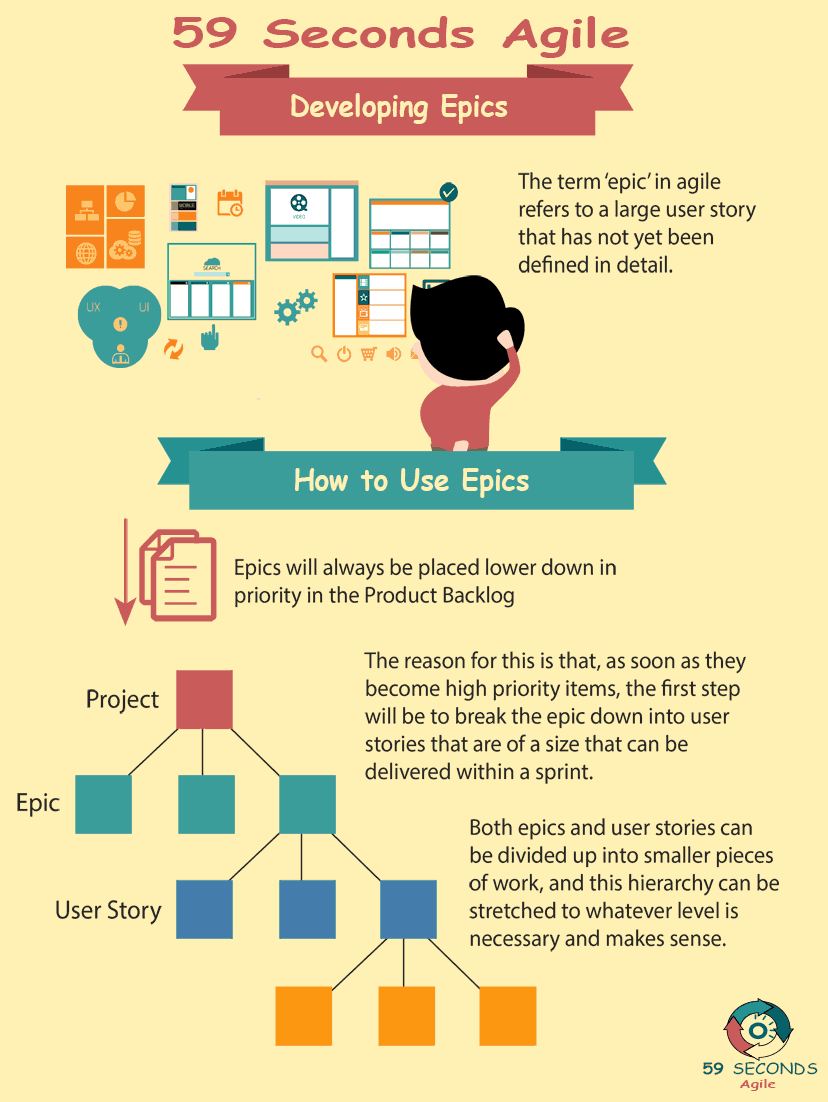What are Epics and who is involved in Developing Agile Epics? and creating them? The Development of Epics is an important part of the planning process within an Agile project.
Developing Agile Epics
A 59 Seconds Agile Video Animation
Developing Epics for Developers
A 59 Seconds Agile Article
Epics and personas are an important part of Agile software development. They allow the Scrum team to get into the heads of the user, and know the intended use of the product. The product owner typically creates the epics and personas. However, the developer role still has an interest in the creation of epics and personas, as they benefit from having well-written epics and personas in a project.
What is an Epic?
In the context of Agile software development, an Epic is basically a large user story. A user story is a task that an average user would want to accomplish in a software product. If a product contains a database of people, a user story might be to access and edit the information of one person. An epic for this product may be to send a mailer to any person in the database with an address listed. The epic clearly involves more steps, and more code development, than the user story.
Developing Agile Epics: User Stories and Epics
Scrum teams make a distinction between user stories and epics because of the difference in development time. A typical user story can be finished within a single sprint. An epic, however, might take multiple sprints to finish. Because of this, the Scrum team will usually break up epics into multiple user stories. Even if the whole epic isn’t finished in a single sprint, each sprint gives more functionality to the stakeholders. Eventually, stakeholders will receive all the functionality required to complete the epic.
Despite their size, epics are typically treated the same as other user stories. They are prioritized into the backlog in the same way. The Scrum team works on them as they would any other functionality. The biggest difference is simply that epics are too large to fit into one sprint. This changes the way that the Scrum team must break them apart.
Epics and personas are an important part of Agile software development. They allow the Scrum team to get into the heads of the user and know the intended use of the product. The product owner typically creates the epics and personas. However, the developer role still has an interest in the creation of epics and personas, as they benefit from having well-written epics and personas in a project.
Developing Agile Epics: What is an Epic?
In the context of Agile software development, an Epic is basically a large user story. A user story is a task that an average user would want to accomplish in a software product. If a product contains a database of people, a user story might be to access and edit the information of one person. An epic for this product may be to send a mailer to any person in the database with an address listed. The epic clearly involves more steps, and more code development, than the user story.
Scrum teams make a distinction between user stories and epics because of the difference in development time. A typical user story can be finished within a single sprint. An epic, however, might take multiple sprints to finish. Because of this, the Scrum team will usually break up epics into multiple user stories. Even if the whole epic isn’t finished in a single sprint, each sprint gives more functionality to the stakeholders. Eventually, stakeholders will receive all the functionality required to complete the epic.
Developing Agile Epics: Size
Despite their size, epics are typically treated the same as other user stories. They are prioritized into the backlog in the same way. The Scrum team works on them as they would any other functionality. The biggest difference is simply that epics are too large to fit into one sprint. This changes the way that the Scrum team must break them apart.
Prev <— Continue Reading —> Next
Learn More: Developing Epics
User Stories Applied
A 59 Seconds Agile Book Review
User Stories Applied by Mike Cohn is one of our favourite books on Agile User Stories. The book starts with an overview into user stories, and details what a user story is and the different aspects of them. He then discusses how to go about writing a user story, and provides details of the INVEST criteria that can be used to determine if the story is meeting all of its objectives. Next Mike gives an in depth discussion of who user stories are written for and where to begin when gathering the details for them. The book then discusses acceptance testing user stories, including how to go about specifying these criteria and the responsibilities of the development team and customers during this process.
Prev <— Continue Reading —> Next
Learn More: Developing Epics
Developing Agile Epics
A 59 Seconds Agile Infographic

Prev <— Continue Reading —> Next
Learn More: Developing Epics
Our Favourite Agile Books
We found these books great for finding out more information on Agile Scrum:

